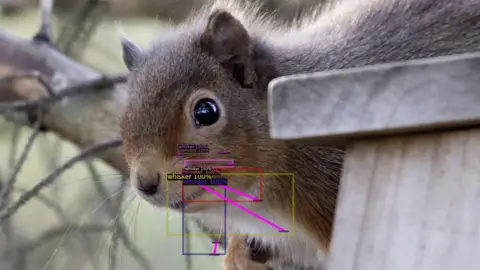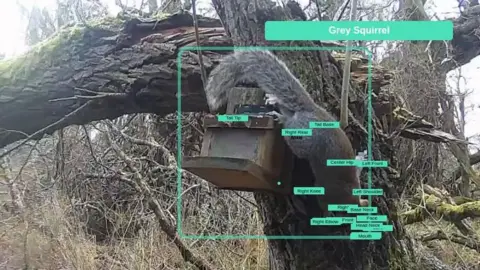ARTICLE AD BOX

 Gensys Engine
Gensys Engine
Whiskers help the AI identify what is - and isn't - a red squirrel
An artificial intelligence (AI) tool which has been trained to tell the difference between grey and red squirrels could be "an absolute game changer", conservationists say.
The system, called Squirrel Agent, has been trained on thousands of images of the animals allowing it to tell them apart with 97% accuracy, its developer says.
It can then be used to automatically control access to squirrel feeders - with only reds being allowed into those containing food, and only greys into those where food has been replaced with contraceptive paste.
“It’s a real showcase of what AI can do,” said Emma McClenaghan, co-founder of Gensys Engine, which developed the tool.
“It’s working in real time to do a task that we don’t have enough [human] volunteers to do.”
Squirrel Agent is currently being tested in sites around the UK in conjunction with five wildlife charities.
Gensys Engine hopes it will eventually be used much more widely not just with squirrels but with other species which would benefit from sophisticated digital monitoring.
Ian Glendinning, from Northern Red Squirrels - one of the conservation groups involved in the trial - told the BBC that, for the animals he is trying to protect, help from technology was urgently needed.
“We are in the bar of the last chance saloon, and the landlord has just called last orders," he said.
Red peril
Grey squirrels are largely responsible for the huge decline in the numbers of red squirrels.
This is partly because there are so many of them, and also because they can carry a virus which they have immunity to but is lethal to red squirrels. They arrived in the UK around 200 years ago.
“Red squirrels are hanging on in Scotland and Ireland, and there are some island populations like Anglesey and the Isle of Wight", explained Mr Glendinning.
"But mainland England and Wales is in dire straits, and they will become extinct if we are unable to reverse this trend."

 Gensys Engine
Gensys Engine
The tech is being trialled in number of UK woodlands
Efforts to preserve red squirrels are further complicated by the fact that, despite their name, not all red squirrels are red.
There are other markers including their tails, ears, size and weight which can also distinguish them from grey squirrels – the vastly dominant population - even if they are the same colour.
The detection process is time-consuming for human observers - but Squirrel Agent uses the power of AI to rapidly analyse all those markers and decide with an extremely high level of accuracy which is which.
It can then automatically decide whether to boost their survival chances by allowing them extra food - or reduce their likelihood of reproducing by steering them towards contraceptives.
By a whisker
Gensys Engine says the next step in the evolution of the tech is to go beyond just distinguishing between the types of squirrel and instead identify individual animals.
This will be done, Emma McClenaghan says, by focusing on their whiskers, which are unique to each animal.
"Whiskers are like a human fingerprints," she says.
By distinguishing between each creature’s whisker tips, as well as their base and length, she hopes AI will enable wildlife experts to track and monitor individual members of the population.
“Over time this data will build up, allowing scientists and researchers to start tracking family lines,” she says.
There are already other examples of AI's ability to process huge amounts of data very quickly being useful for conservationists.
For example, the World Wildlife Fund (WWF) used the tech to analyse millions of photographs of a large area of Australia wiped out by bushfires, in order to find places where animals had survived.
It has also been taken up by hobbyists, with a British man telling BBC News last year how he had devised a tool - dubbed the Furbinator 3000 - to stop foxes and badgers fouling his Surrey garden.

 4 months ago
29
4 months ago
29








 English (US) ·
English (US) ·